Do you know of a 1964/1965 World's Fair
Legacy?
If you know of a Legacy of the 1964/1965
World's Fair that isn't listed on these pages, or if you have
additional information on listings that you'd like to share,
please contact Bill Young at nywf64.com.
Thank you!
|
| Dave Kelly reports "If you
are looking for another remnant from the fair, look in Groton,
Connecticut. St. Mary's Catholic Church was the rotunda at the
Vatican Pavilion." - April 23, 2000 |
|
|
Curtis Cates of BBQ Productions
sent along these photos of remnants of the Vatican Pavilion
- May 17, 2000
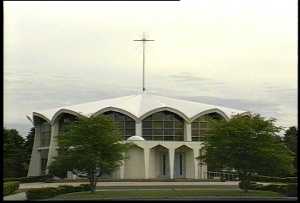
Vatican Pavilion Starburst,
St. Mary's Catholic Church, Groton
Interior view of Stained
Glass
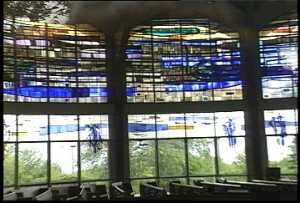
Curtis also reports that the
bas relief sculpture displayed on the exterior entrance wall
of the Vatican Pavilion can be found in Kennebunk, Maine
(photos courtesy Leigh Block)
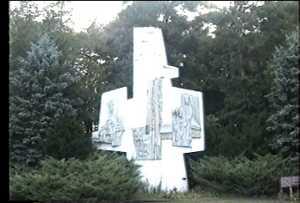
The accompanying plaque
states: "This magnificent sculpture, designed and executed
by Vytautask Jonyans, adorned the facade of the Vatican Pavilion
at the World's Fair in New York City (1964-1965). It depicts
the church militant, the church suffering, and the church triumphant,
that is, the church here on Earth, in Purgatory and Heaven. In
1967 the Franciscans in Kennebunk, Me dedicated this historical
work of art to the silent church in Lithuania."
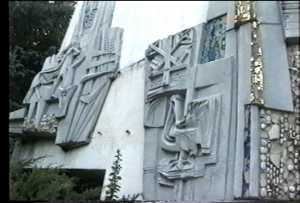
|
|
| BBQ Productions' website lists a link to
the Mankato
State University Website where they claim to have a World's
Fair Fountain. It appears that it might be a re-arrangement
of the Fountains of the Fair. Perhaps a visitor can verify what
fountain it is. Elizabeth Klug - April 26, 2000 |
Visitor Dot Condon writes "I
don't know if it's still there, but the front
of the Ireland Pavilion was used for the front of a restaurant
in NYC. I think it was on East 57th Street, near 3rd Avenue.
It's been a few years since I was around there." - April
25, 2000 |
| Eugene Brennan reports that "another
exhibit out there that exists fully intact is the replica of
the H.M.S. Bounty
which was built by MGM in 1960 for its film of the same name.
This ship was anchored in Flushing Bay area near the WF Marina
and was listed and described in the 1964 official guidebook as
a Fair attraction in the 'Flushing Bay Area' along with the Marina
and Shea Stadium. I believe the Bounty only exhibited for the
'64 season and had sailed on by the time '65 rolled around. It
had several owners through the years including Ted Turner. Currently
it is anchored and permanently based in St. Petersburg, FL."
- May 1, 2000 |
| Mr. Brennan also had this interesting
observation on an unusual Fair Legacy: "Here's a
little known phenomena; about a year ago I visited Flushing Meadow
Park in the Fall. At places the grass which is located where
the '64-'65 buildings were located was actually a slightly different
color than topsoil where there were no pavilions. In some
places you could make out the building lines, particularly
around the Unisphere/NY State Pavilion area. Either the City
replanted those sites with a different type of grass or the buried
foundations are affecting the topsoil overhead. In addition,
the structural foundation of the Trylon buried after the
'39 fair is 'rising up' next to the Unisphere due to the settling
of the landfill on which the Park is laid out. With a little
imagination it almost looked like ghost buildings of the Fairs
reasserting themselves! I have not been there since so I
can't say this is still the case. Only a true NYWF fanatic would
appreciate the beauty and irony of this!" - May 1, 2000 |
|
Two display cars from the Long
Island Railroad Display are in the process of being restored
at Mitchell Field in Uniondale, NY. as reported by Wayne Beers.
The restoration group's web page reports: "The front end
of an ALCo. FA-1 cab unit locomotive ... and the tail end of
an observation car were used to attract visitors to what the
railroad had to offer. After the fair ended, the displays were
donated to Camp Tanglewood, a day camp in Lynbrook, NY. They
sat there until the camp closed it's doors."
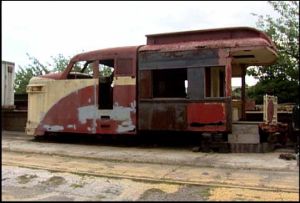 Front end of cab / Tail end of observation
car Front end of cab / Tail end of observation
car
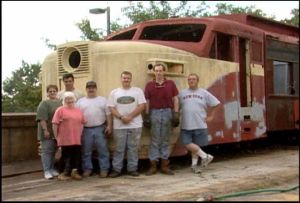 Restoration group poses. Restoration group poses.
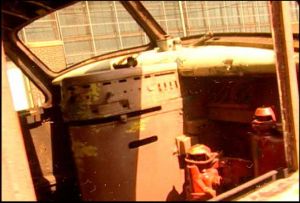 Interior restoration. Anyone with pictures
of original interior, please contact Wayne Beers. Interior restoration. Anyone with pictures
of original interior, please contact Wayne Beers.
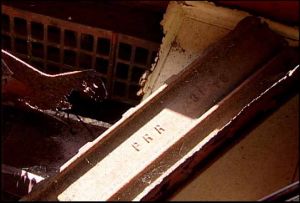 Restoration shot. Restoration shot.
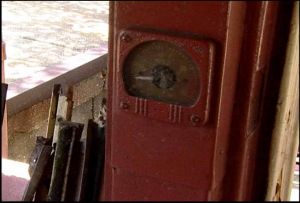 On-going restoration. On-going restoration.
Photos courtesy Curtis Cates
of BBQ Productions
|
| The Christian Science Pavilion
was shipped via the Panama Canal to Poway, California where it
became a Christian Science church. Sadly, the church/pavilion
was demolished in 2006 to make way for a new sanctuary. The church
in Poway tried to sell the pavilion for $1 to anyone who would
remove it from the Poway site. They were unable to find any takers
for the offer and the structure was demolished. World's Fair
enthusiast Gary Holmes salvaged one of the skylights from the
pavilion and it is awaiting restoration at his home. |
|
Mr. Yowell posted the following
on the Message Board: "For those interested in what happened
to Greyhound's Glide-A-Rides after the Fair, page 96 of
the October 8, 1965 Time Magazine provides some clues.
- May 7, 2000
To read a reprint of this
October 8, 1965 Time Magazine article, entitled "BARGAINS
- The Great Souvenir Sale", see Page 2.
|
| Marty Biniasz of Buffalo NY sent
the following: "As for the Greyhound Glide-A-Ride vehicles,
many of them have been operating on the grounds of the Erie County
Fair in Buffalo. In addition to the 64/65 trains, the EC Fair
also have vehicles from the 67 Fair. Until a recent paint job,
you could see the Glide-A-Ride logos. The trains are in good
condition but the fiberglass is starting to give out after many
years of use. They are a little ruff around the edges."
- June 5, 2000 |
| Several visitors have taken me to
task for not including the Disney exhibits in the list
of Legacies. My apologies, as they are wonderful legacies that
we all can still enjoy today! Dean Lundstrom writes: "With
regards to your Legacies, I would like to point out some very
obvious ones which I don't think too many people nowadays connect
to the '64 fair. Four of the top five shows were produced by
Walt Disney and, as I'm sure you know, all of them can be seen
in the Disney parks. They have changed a bit but are more or
less true to their original content. These include: "Great
Moments with Mr. Lincoln" from the Illinois pavilion
who can be seen at the Main Street Opera House in Disneyland;
"It's A Small World" from the Pepsi Cola pavilion
which is at most of the parks but the version at Disneyland is
probably closest to the original with the fiberglass flume for
the boats to travel in; an updated "Carousel of Progress"
from the General Electric pavilion that can be seen at Disney
World's Magic Kingdom with the original theme song restored to
the show; and the Ford pavilion dinosaurs that now reside
in a primeval diorama alongside the Disneyland Railroad." |
|
An article appeared in late '65
or early '66 in the New York Times entitled "World's
Fair Pavilion Will Get New Life as Office Building" The
article states: The India Pavilion of the 1964-65 World's
Fair will rise again. The pavilion, now lying in heaps in a lot
in Lyndhurst, NJ will become an office building in nearby Clifton.
Helm enterprises of Passaic, an organization headed by Howard
Greef, has purchased the pavilion and plans to reconstruct it
on a two-acre site facing the Garden State Parkway ... When the
fair closed, the building was sold to a Lyndhurst branch of a
Swiss chemicals company, which has now sold it to Helm. The pavilion
had been carefully dismantled and all its trusses, beams and
panels numbered so that the building could be re-assembled on
another site ... Helm plans to double its size. Glass will be
used to stretch the facade and to enclose an area of 40,000 square
feet, an increase of 20,000 square feet. The rotunda, which originally
housed a restaurant, will look as it did at the fair, but an
advertising agency -- Martin-Sands -- will occupy it."
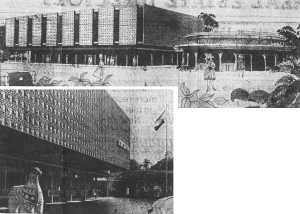 Artist's sketch
of how the re-assembled pavilion would look on its Clifton NJ
site. Smaller inset shows the pavilion on its site at the Fair. Artist's sketch
of how the re-assembled pavilion would look on its Clifton NJ
site. Smaller inset shows the pavilion on its site at the Fair.
Does anyone know if the pavilion
was ever reconstructed in Clifton? Does such a structure exist
along the Garden State Parkway. Please send eMail if you can
shed light on this World's Fair mystery.
|
|
Mike Kraus passed along this
photo of the Lithuanian Wayside Shrine, displayed in the Garden
of Meditation at the Fair. NYWF '64 Collector John Riccardelli
believes it was restored and placed in Central Park. Mike says
"If this can be confirmed, then we have another Legacy item!"
- July 9, 2000
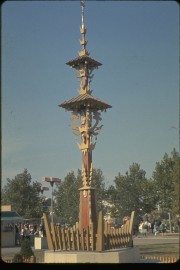
|
Bruce Mentone forwarded this review
he found in the Queens Tribune of La Motta’s Waterside
Restaurant: 10 Matinecock Ave., Port Washington:
|
"As for their their 'red
and white umbrella,' it was built by Owens-Corning Fiberglass
Corporation as part of the Sinclair Oil company’s exhibition
at the 1964/65 New York World’s Fair. Their history on the
back of each menu explains 'Sinclair was awarded the contract
to supply fuel to the fair’s 825-boat state-of-the-art marina
in Flushing Bay, and they placed the umbrella over the floating
fuel dock at the front of the marina. The umbrella became the
main attraction of the World’s Fair Marina and the focus
of thousands of photographs.'
The dock was abandoned after
the fair, and in 1968 Mario S. LaMotta joined with Sinclair Oil
to renovate the dock and tow it to Manhasset Bay where it sat
at the head of the Bay Marina and was used once again for refueling.
When the Marina began construction of LaMotta’s waterside
restaurant in 1993, the historic 'umbrella' was built in to the
restaurant’s construction and now serves as an easy landmark
from the coast on the water as you near the restaurant as well
as the protection for a different kind of world-class fare.
— Tamara Hartman, Queens
Tribune"
|
|
|
Robert Santos Jr. writes: "Are
you aware that the SkyRide that was at the Fair exists and is
still used today at Six Flags Great Adventure here in New Jersey?
I noticed a commerative plaque on one of the steel uprights that
documented its history while at the park recently. The plaque
was kind of hidden and was the only reference to the ride's history."
- October 16, 2000
Commemorative plaque at Six Flags
- photo courtesy of Charles Aybar
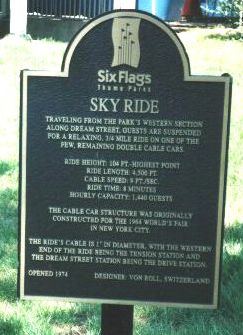 |
|
| "I worked at the Mormon Pavilion
in both '64 & '65. It was the first exhibit on your left
as you came in the main gate to the Fair. In front was a replica
of the east 3 spires of the Salt Lake City Mormon temple. After
the Fair the precast stone slabs that made up the walls of the
main building were transported to Plainview, LI, NY and there
became the walls of the new Plainview Chapel of the Church of
Jesus Christ of Latter Day Saints. The chapel was recently refurbished
and still looks good as new." Phil Terrill, Bountiful, Utah,
March 15, 2001. |
| "At the entrance to the parking
lot of the town pool in Garden City, NY (Long Island) is a sculpture
of a dolphin (porpoise) which was originally from the Florida
Pavilion." Donald B. O'Neil, May 31, 2001. |
|
"I'm forwarding a colored
photo of the sculpture that was on the ground level (west side)
of the United States Pavilion. It is now located at the Farleigh
Dickinson College in Teaneck, NJ It has markings on it that it
was commissioned for the 1964 New York World's Fair" Bob
Tremper, February 10, 2002.
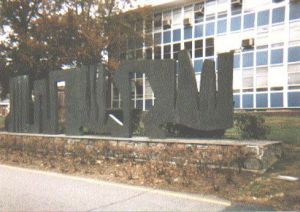
|
|
Mr. John Brennan was involved
with the demoliton of the Japanese Pavilion and prepared
the stones of the beautiful Japanese Wall to be transported
to Manhattanville College in Purchase, NY. Mr. Brennan
writes:
The Japanese Pavilion at the
Fair was a square in its outline. The exterior walls were made
of concrete. These walls sloped inward and were about 20 feet
high. It was as if it were to become a pyramid, but it was a
pyramid that was cut off when it reached some 20 feet in height.
When these concrete walls were done, the plans called for a facade,
made of lava stones, to be laid up on the outside faces of these
sloping walls.These stones were dark in color, almost a black.
They varied in size but had a varying thickness of about eight
inches, as I remember them. They each could be carried by one
man.They were to be set about one inch from the outside faces
of the walls. The one inch space between the walls and the stones
was to be filled with mortar. This method of building the facing
material onto an existing wall was a technique well known in
Japan but not so in the United States. It required, after the
stones were set in place, that the joints between them be stuffed
with rags to prevent leakage of the mortar. The high strength
mortar (5000 P.S.I., I believe) was then mixed and carefully
ladled into the space behind the stones. The rags were left iin
place until the mortar had become solid. This procedure was carried
out by workmen who had been brought in from Japan for the purpose.
In order for them to work, it was necessary to get the approval
of the Bricklayers' union in New York, which had jurisdiction
of the work there. A deal was struck and the Japanese workers
were approved. I do not know the details of that deal. When the
rags were removed from between the joints, the visible parts
of the lava stones were not stained and the mortar itself was
at least one inch inwards of the surface of the stones. There
were also carvings made in the lava stones. These carvings extended
over many stones and each one had a special meaning. I am not
sure what those meanings were, but they would have been significant
to a knowledgeable person I think, but am not sure, that these
carvings were made after the stones had been set. For example,
there was a carving of the sun in its course through the sky.
This carving was 20 or more feet in length. It would, I think,
have been impossible to make this meaningful carving before the
stones were laid up.
Another part of the gift to Manhattanville
College was the stones and the sculpture that the designers of
the pavillion had used in the decorative gardens outside the
building itself. The placement of these garden stones and sculptures
was a consideration of great importance. The sculptures in this
portion of the gift were made by a very well-known Japanese sculptor
by the name of Noguchi.
When the time came for me to
deliver on my promise to transport both the lava stones and the
garden stones and sculptures, we had to think of the best way
we could preserve the stones without damaging them too much in
the process. The garden stones and sculptures did not present
a problem since they were not fixed in place and could be readily
gotten at. The lava stones, however, were another matter. They
were affixed to the building with 5000 P.S.I. mortar. I probably
do not remember, nor will I try to tell, all the alternative
ways we considered, but I do remember what we did. First we painted
on each stone a serial number which would identify where it had
been set in the wall. Then we hired a photographer who was to
take pictures of each outdside face of the wall. These photographs
were to show the numbers on each stone and would preserve a record
of the carving in the stones. We then hired a crane with a wrecking
ball. The crane would swing the ball and hit the inside of the
wall and thereby "pop" the lava stones off the outside
face. This worked well enough and the stones along with the photographs
were delivered to the college. Where exactly the stones were
located on the campus I do not know. The photographs, no doubt,
were given to the administration up there. Submitted May 8, 2002.
|
|
|
Jim Crouch, Woodward, Oklahoma
writes: "These photo's are of what I believe to be the street
lamps from 64-65 NYWF that are now in the Oklahoma City State
Fair Park. The entire Fair Grounds used to be swarmed with
these lamps. What remains today you pretty much have pics of.
They are in two locations. Approx 26 of them (two rows of approx
13) are in front of the "Travel And Transportation building"
(where you see the B-52) and about 12 in one row in front of
"Made In Oklahoma Building" (where you see a row of
pointed roofs). I should have counted them to be exact. But that
is darn close. These are slowly being replaced with newer lamps!"
Jim also reports that a park bench from the Oklahoma pavilion
is located in Woodward, OK. - August 6, 2002
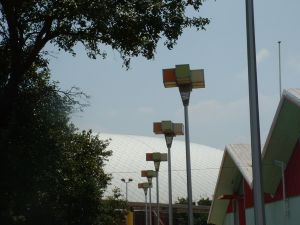
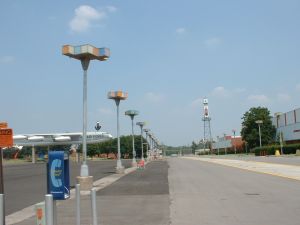
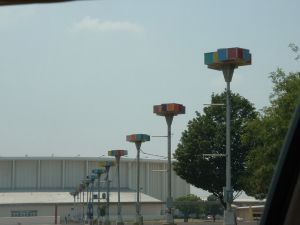
|
|
Brad Rim reports the discovery
of still more World's Fair street lights at the Hotel Villa Vosilla
at Hunter Mountain in Upstate New York - December, 2002
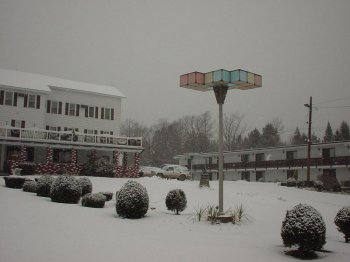
|
| "I did not see mentioned on
your site the liturgical banners from the Vatican Pavilion. For
many years, they were hung in Rockefeller Memorial Chapel and
Harper Library at the University of Chicago. Because of deterioration,
the banners were taken down for archival conservation. Perhaps
someone at the University has more information or pictures."
John Allread, December 13, 2002 |
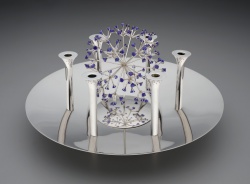 Kevin W. Tucker reports that the
Celestial Centerpiece, created for and displayed at International
Silver's exhibit in the Pavilion
of American Interiors has been acquired by the Dallas Museum
of Art. Mr. Tucker, The Margot B. Perot Curator of Decorative
Arts and Design of the Dallas Museum of Art said, "The Celestial
Centerpiece is an exceptional realization of the futuristic
visions of the Space Age and unquestionably stands as one of
the most significant American silver objects produced in the
latter half of the 20th century." August 2, 2005 Kevin W. Tucker reports that the
Celestial Centerpiece, created for and displayed at International
Silver's exhibit in the Pavilion
of American Interiors has been acquired by the Dallas Museum
of Art. Mr. Tucker, The Margot B. Perot Curator of Decorative
Arts and Design of the Dallas Museum of Art said, "The Celestial
Centerpiece is an exceptional realization of the futuristic
visions of the Space Age and unquestionably stands as one of
the most significant American silver objects produced in the
latter half of the 20th century." August 2, 2005 |
|
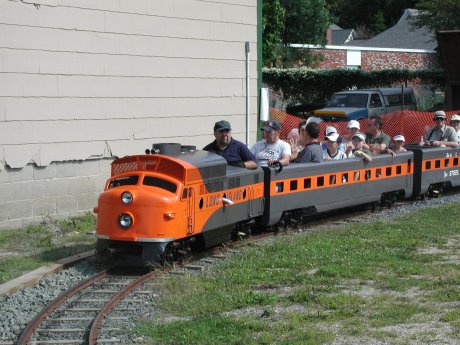 Ray
Liotti reports that the miniature
train of the Long Island Railroad Exhibit has been
restored and is in operation at the Railroad Museum of Long Island
in Riverhead, New York. September 1, 2004 Ray
Liotti reports that the miniature
train of the Long Island Railroad Exhibit has been
restored and is in operation at the Railroad Museum of Long Island
in Riverhead, New York. September 1, 2004
(Photo courtesy of Greg Gottlieb)
|
| "The probability machine used
in the IBM pavilion was part of an exhibit of The Pacific Science
Center in Seattle, Washington. It was used in conjunction with
a permanent mathamatics exhibit sponsored by IBM. I remember
seeing it during most of my visits to the Science Center during
the 1970s and 1980s. It must have ended up in the Science Centers
hands shortly after the Fair was over. It was visible from the
road outside the Science Center as well since it was very tall.
During a major renovation to the Science Center in 1990 the exhibit
was converted to a new group visitor entrance and the probability
machine went along with it. It's possible the Science Center
has it in storage to use in future exhibits." Tim Babcock,
March 1, 2007. |
|